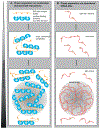Multiple Modes of Protein-Protein Interactions Promote RNP Granule Assembly
- PMID: 30099026
- PMCID: PMC6204294
- DOI: 10.1016/j.jmb.2018.08.005
Multiple Modes of Protein-Protein Interactions Promote RNP Granule Assembly
Abstract
Eukaryotic cells are known to contain a wide variety of RNA-protein assemblies, collectively referred to as RNP granules. RNP granules form from a combination of RNA-RNA, protein-RNA, and protein-protein interactions. In addition, RNP granules are enriched in proteins with intrinsically disordered regions (IDRs), which are frequently appended to a well-folded domain of the same protein. This structural organization of RNP granule components allows for a diverse set of protein-protein interactions including traditional structured interactions between well-folded domains, interactions of short linear motifs in IDRs with the surface of well-folded domains, interactions of short motifs within IDRs that weakly interact with related motifs, and weak interactions involving at most transient ordering of IDRs and folded domains with other components. In addition, both well-folded domains and IDRs in granule components frequently interact with RNA and thereby can contribute to RNP granule assembly. We discuss the contribution of these interactions to liquid-liquid phase separation and the possible role of phase separation in the assembly of RNP granules. We expect that these principles also apply to other non-membrane bound organelles and large assemblies in the cell.
Keywords: RNA; intrinsically disordered regions; phase separation.
Copyright © 2018 Elsevier Ltd. All rights reserved.
Figures




References
Publication types
MeSH terms
Substances
Grants and funding
LinkOut - more resources
Full Text Sources
Other Literature Sources

